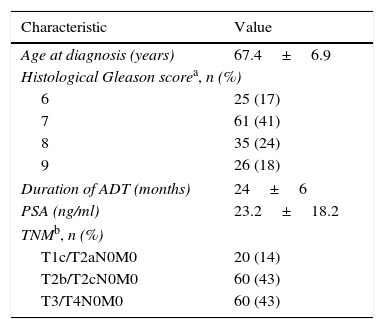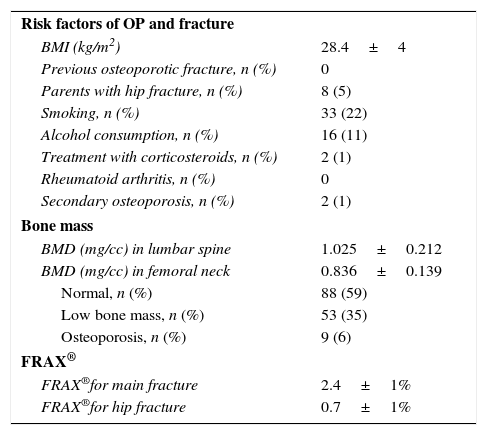To determine the rate of bone mass loss and the risk of fracture induced by androgen deprivation therapy in patients with prostate cancer.
Material and methodsProspective study in 2 phases. In the first phase, demographic variables, FRAX®, bone mineral density and clinical fractures were collected, before starting the therapy and up to 1 year after ending the therapy. In the second phase, we conducted a telephone interview a mean of 8.5 years after the start of the study to assess new fractures.
ResultsWe included 150 patients with a mean age of 67 years and a mean therapy duration of 24 months. Before starting the treatment, 62 patients (41%) showed osteoporosis or low bone mass in the densitometry. After the first year of treatment, the bone mineral density decreased a mean of 3.7% and 2.1% in the lumbar spine and femoral neck, respectively. At the end of the second and third year, the loss rate was lower. During the first phase of the study, 4 patients (2.7%) experienced a fracture. In the telephone interviews with 80 patients (53%), only 1 had experienced a fracture.
ConclusionsIn the patients with prostate cancer and androgen deprivation therapy, greater bone loss occurred during the first year. When the treatment did not exceed 2 years, the absolute risk of fracture was low, and clinical fractures were uncommon in the short and long term.
Determinar el porcentaje de pérdida de masa ósea y el riesgo de fractura inducido por la terapia de deprivación androgénica en pacientes con cáncer de próstata.
Material y métodosEstudio prospectivo en 2 fases. En la primera se recogieron variables demográficas, FRAX®, densidad mineral ósea y fracturas clínicas antes de iniciar la terapia y hasta un año después de finalizada. En la segunda se realizó una entrevista telefónica una media de 8,5 años después del inicio del estudio para evaluar nuevas fracturas.
ResultadosSe incluyeron 150 pacientes con una edad media de 67 años y duración media de la terapia de 24 meses. Antes del inicio del tratamiento 62 pacientes (41%) presentaban osteoporosis o baja masa ósea en la densitometría. Después del primer año de tratamiento la densidad mineral ósea descendió una media de 3,7% y 2,1% en la columna lumbar y el cuello femoral, respectivamente. Al final del segundo y tercer año el porcentaje de pérdida fue menor. Durante la primera fase del estudio 4 pacientes (2,7%) sufrieron una fractura. En la entrevista telefónica a 80 pacientes (53%) solo uno había sufrido una fractura.
ConclusionesEn los pacientes con cáncer de próstata y terapia de deprivación androgénica la mayor pérdida ósea se produce durante el primer año. Cuando el tratamiento no supera los 2 años el riesgo absoluto de fractura es bajo, y la fractura clínica infrecuente a corto y a largo plazo.









